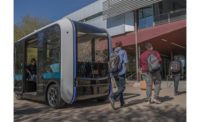Driving The Technology Discussion
How a California County's Mobility Mavens Are Creating a Future With Autonomous Vehicles
The Contra Costa County plan includes training for intelligent transportation systems

CCTA envisions a mobility system that includes autonomous and connected vehicles, transit and smart highways.
IMAGE COURTESY OF CCTA

CCTA used a LIDARequipped drone to measure cut-and-fill on an interchange project
PHOTO COURTESY OF CCTA

CCTA, with a staff of 20, has earned a reputation as “owner of choice” for contractors.
PHOTO COURTESY OF CCTA

Iwasaki stands next to a test shuttle.
PHOTO COURTESY OF CCTA

Iwasaki came up with the idea of GoMentum, the nation’s largest testing ground for autonomous vehicles.
PHOTO COURTESY OF CCTA





W
hen the pandemic began affecting California this spring, the Contra Costa Transportation Authority (CCTA) wasted little time in doing what it has come to be known for—forging partnerships. CCTA teamed with Brosamer & Wall—the contractor on the $136-million Interstate 680/Highway 4 Interchange Improvements project—to create a COVID-19 Safety Compliance Officer position.
In August, CCTA opened 11 miles of a southbound new express lane on a separate I-680 project, one year ahead of schedule. Bay Cities Paving & Grading Inc. accelerated work on the $123.2-million project by taking advantage of reduced traffic. It expects to finish converting the lane into a tolled lane early next year.
“You can’t find a better agency to work for,” says Ben Rodriguez, president of Bay Cities Paving and Grading. “The processes they’ve developed make it a pleasure to do business with them.”
Those processes include prompt payments—within five days—and technologies such as drones and paperless documentation, Rodriguez says. The project also utilized the Infra-Red Traffic Logger (TIRTL), a multipurpose traffic sensor that uses infrared light cones to record speeds and volumes of traffic. “This technology will allow for a lot more than counting cars,” says Rodriguez.
The CCTA is led by Executive Director Randell (Randy) Iwasaki. When he retires this December after a 10-year stint, he will leave an agency that, with only 20 staff members, has earned a reputation as a leader in pushing cutting-edge transportation technology.
CCTA’s highest-profile effort is GoMentum Station, the nation’s largest dedicated secure testing facility for connected and automated vehicle (AV) technology. CCTA acquired the former military station and announced it would be a testing site for AVs in 2014. Now owned and operated by AAA Northern California, Nevada & Utah, the 2,100-acre facility in Concord, Calif., includes 22 miles of roads, 48 intersections and eight testing zones. CCTA, in partnership with the AAA and other entities, last year won a $7.5-million grant from the U.S. Dept. of Transportation to support a four-year Automated Driving System (ADS) pilot program for three “real-world” demonstration projects.
The projects are: shared AV transportation for a senior community; AV shuttle service with a self-docking wheelchair apparatus for a county hospital; and the preparation of the I-680 corridor for connected AVs with vehicle-to-technology and vehicle-to-vehicle infrastructure.
Local Motors, the manufacturer of the two autonomous shuttles intended to serve the retirement community, expects to deliver them for testing by the end of this year, says president Vikrant Aggarwal. “Randy is very progressive and uses the CCTA platform effectively in moving the needle on solving transportation challenges,” Aggarwal says. “He is not only thinking about tomorrow, but further out.”
Visionary Veteran
The thinking extends to training the next generation. CCTA facilitated a partnership with Local Motors and Pittsburg High School, which is set to expand its auto mechanic program to include maintenance and repair of AVs and electric vehicles. “I had seen some presentations CCTA did about AVs in 2017,” says Sherene Sasser, workforce liaison for the Pittsburg Unified School District. The following year, the school hired a “very progressive” automotive teacher, and Sasser learned about the California Dept. of Education’s K-12 Strong Workforce grant program.
Sasser met with CCTA. “We made our pitch and gave them three options: Buick, Benz and Bentley,” Sasser says, using a metaphor for the levels of support. “They came back and offered us a Bugatti level. They introduced us to Local Motors, who donated an AV.” The school won a $600,000 grant and raised $1.2 million through other partners.
“You can’t find a better agency to work for.”
– Ben Rodriguez, president of Bay Cities Paving and Grading, on the CCTA
Iwasaki spent most of his career at the California Dept. of Transportation, becoming its director in 2009. “Randy has a lot to do with the agency being leaning-forward,” says Malcolm Dougherty, also a former Caltrans director and now senior vice president with Michael Baker International. “He pushed the envelope at Caltrans on new technology. Caltrans’ involvement with ITS [Intelligent Transportation Society of America] was his initiative.”
Dougherty says that Caltrans and the Michigan Dept. of Transportation were early leaders in looking at intelligent transportation technologies such as AVs. “Only a handful of local agencies have emerged to that same level, and CCTA is one of them,” he adds.
Last month, CCTA announced a partnership with the Minnesota Dept. of Transportation to share knowledge and testing facilities for intelligent transportation. CCTA will have access to the DOT’s 50 road test sections, and MnDOT will have access to GoMentum.
Bart Ney, a Caltrans spokesperson, recalls working with CCTA in 2017 when his former employer Alta Vista Solutions proposed using a drone equipped with LIDAR to document cut-and-fill work on a $74-million interchange project. “Randy has worked with leaders in the technology field to pioneer new technologies in transportation,” says Ney. “Beyond that, Randy set an example for his agency to work with consultants and contractors as a team. The integrated approach his project managers have used has benefited the taxpayers living in his district, as the CCTA has become an owner of choice for contractors bidding on projects.”
Sam Hassoun, founder of GLA, a consulting firm that specializes in collaborative dispute mitigation, says the CCTA has accomplished GLA’s main goal for the industry: Over Iwasaki’s 10-year tenure, there has been no litigation on projects. “They don’t even have a dispute resolution board anymore,” says Hassoun. “No claims. That’s something we would like to exponentially replicate in the industry.”
Eric Lilly, construction services area manager with WSP, concurs. “Their partnering approach separates them,” he says. “In day-to-day operations, CCTA expects us to work with contractors and other agencies. On CCTA projects, from day one the contractor knows their reputation … it creates a good tone throughout the project. If something comes up, we’ll find a solution that’s best for the project and good for everybody.”
“Randy has always been the catalyst to get things done,” says William Hadaya, president & CEO of WMH Corp. “He wants to make sure contractors get paid fairly.” He adds: “I would say he added the technology flair to the agency that it didn’t have.”
Mark Reno, principal engineer with Quincy Engineering and transportation infrastructure chair at the Transportation Research Board (TRB), also notes Iwasaki’s nurturing of his staff. “He’s always pushing his folks to learn more and be associated with organizations,” says Reno.
“[Iwasaki] is not only thinking about tomorrow, but further out.”
– Vikrant Aggarwal, president of Local Motors
Iwasaki says he was one of “a lucky few” during his career at Caltrans who was able to travel to industry conferences such as those held by TRB and ITS America. “It taught me to pay attention to research,” he says. When in charge at Caltrans, he once sent 38 employees to TRB, he says. “Then I’d ask [them], ‘What did you learn and what will you deploy when you get back?’ ”
His cost justification: “A CFO tells the CEO, ‘What happens if we train all these people and they leave?’ The CEO says: ‘What happens if we don’t train them and they stay? Treat them right, so that they do stay.’ ” Before he joined CCTA in 2010, Iwasaki received offers from agencies that would not allow for travel, and declined.
Julie Pierce, chair of the CCTA board and mayor of Clayton, Calif., credits Iwasaki’s emphasis on learning with the agency’s rise as a technology-forward leader. “It was because Randy is so connected with technology around the world—he was able to come back and tell us time after time of meetings at ITS and other conferences. Other people are doing stuff that’s really innovative, and we need to learn.”
CCTA eventually took the reins of its own projects from Caltrans. To do so, Iwasaki recruited Ivan Ramirez from Caltrans to handle construction in 2012. “Randy and I started administering our own contracts,” says Ramirez. “It was a major shift for us.” The $417-million Caldecott Tunnel Fourth Bore project was completed in 2013 on time and on budget right before the transition. “My role changed from managing the excavation of the tunnel [with Caltrans] to overseeing the overall project for CCTA,” says Ramirez.
Pierce notes that CCTA set up an executive board team to keep the contracting process streamlined. “Randy can send us a change order request and outline the reasons, we all read it, and we immediately get back to him. Typically it’s a two-day turnaround,” she says.
Dave Campbell, advocacy director with Bike East Bay, praises CCTA for being transparent and open to suggestions, but critiques it for still prioritizing highway work over walkability/bikeability needs. “I’d say that innovation is not the only way to address problems caused by driving,” he says.
However, Bike East Bay went from being part of a lawsuit against the Fourth Bore project to looking forward to working with CCTA, he says.
CCTA is deploying an $8-million, three-year grant from the Federal Highway Administration, won last year, to enhance Mobility-on-Demand (MOD) applications in the Bay Area. CCTA was the only local government agency chosen for a grant, and the only recipient in California.
The grant, along with the three pilot AV projects, is part of the Innovate 680 corridor program. The other projects include adding a northbound express lane, allowing buses on shoulders during peak traffic, creating shared mobility hubs along I-680 where multiple modes come together, implementing smart traffic signals and adaptive ramp metering, and creating an MOD app that will provide real-time, multimodal trip planning options. All are under development in collaboration with a multitude of agencies including Caltrans, local transit agencies, private groups and academia.
In September, 511 Contra Costa announced a partnership with CCTA to offer a limited number of $150 rebates ($300 for low-income residents) to assist residents with buying e-bikes, e-bike conversion kits and electric mopeds.
“We’re a small peashooter organization,” jokes Pierce. “But look what we can do.”









